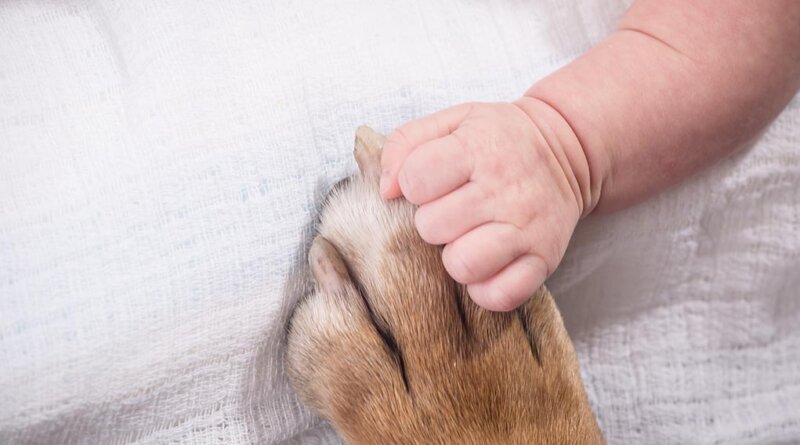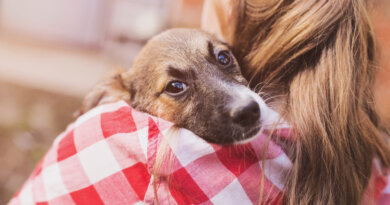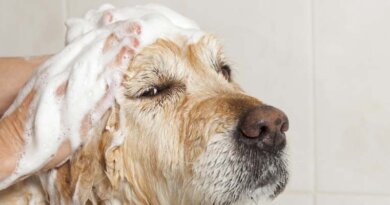14 Best Tips on Introduction and Their Life Together
Introducing dogs to kids and vice versa is an important step. As a dog owner bringing home a newborn from the hospital, there are a million “what ifs” circling around in your head about dogs and newborns.
What if your pet doesn’t take to the baby? What if the dog takes too well to the baby and won’t let you near them? What if your dog accidentally sits on the baby? Not to spike up your anxiety, but such questions are (or will be) endless. The good news is that with some guidance and a proper introduction, your newborn and your dog can become fast friends.
Kids reap many benefits from growing up around dogs, and bringing home a newborn baby shouldn’t change much around your household. But statistics show that majority of dog bites occur with children. It’s crucial to teach a dog to get along with children as early as possible. Below are a few things to keep in mind when introducing a newborn to a dog.
Early Preparations for Dogs and Newborns
1. Make Your Dog Part of the Pregnancy
Begin the introduction process early by making your pet a part of your pregnancy. The dog will undoubtedly notice changes taking place around the home as well as with you physically; you will smell and look different throughout your pregnancy. The key to strong friendship between dogs and newborns is a head start.
Include your dog in most of the pregnancy process, allow them to be close to you, to “investigate” your growing belly, and give them attention as you normally would. Go for your daily walks (if you can’t do it, hire someone who can), feed them on time, play with them regularly, cuddle on the couch, and so on. Do all the things you did with them before you got pregnant.
Most importantly, avoid excluding your dog or making significant changes to their routine. This can result in behavioral changes such as “acting out”. Dogs thrive on routine and a change can make them feel fearful or unsteady. Likewise, excluding dogs will not only create more curiosity, but will also breed feelings of jealousy and resentment that will cause more complicated problematic behaviors during and after the pregnancy.
2. Reinforce Your Position as a Leader Mom
If your dog has become a little “too big for their boots” lately, now is the time to reinforce your status in the home. This doesn’t mean that you have to be a jerk to the dog, nor that you have to employ outdated “alpha dog” principles. But it does mean that you have to re-establish control and authority, like a mother of dogs and newborns would.
Practice obedience and stop letting certain things slide. For example, if you started letting your dog take food from your plate, stop this right away and use a more “dog-friendly” approach: put that food in their bowl instead. This prevents problematic behavior by reinforcing respect and reaffirming to the dog that they aren’t on an equal level with you or other humans in the house (even if they are in your heart).
Dogs learn best from positive reinforcement. Do not use punishment or negative reinforcement to dissuade your dog from behaviors – this creates a lack of trust in you which leads to a lack of confidence in your ability to lead the dog. That type of training approach also increases dog’s anxiety which may lead only to more issues later on.
3. Practice Obedience
Practicing obedience is the best way to reinforce your position as someone who makes the final decision in this household. It also important establishes control over a dog’s behavior. With a well-trained dog, you have the confidence of knowing that no matter what happens with your new baby, you can trust your Fido to obey a sit, stay, or leave it command.
For example, if a new baby starts to cry, the dog may be compelled to run to the nursery. If you are running for the nursery at the same time, you could easily trip and fall. More problems may arise with your dog panicking or trying to play while you care for your newborn baby. But if you are confident in a dog’s obedience skills, then you can tell them to sit and stay while you go to the nursery and not have to worry about a dog’s behavior.
Obedience is also important in teaching acceptable and unacceptable behaviors that your dog may not yet know. For example, if you have always played rope tug games, they can get a little rough. Take this opportunity to teach a dog “gentle play” command so that he knows when they need to be cautious while playing around a child. That way a dog understands that they can still play their traditional games with you, but when playing around your baby, they must modify their behavior.
4. Establish Boundaries
As you work on dog obedience training, do some work on establishing both personal and territorial boundaries between dogs and newborns. For example, the mentioned gentle play command is a great way to establish boundaries by creating verbal cues. You can create a range of commands to help your dogs understand what they may and may not do around your new baby.
This means that rather than simply telling your dog “No!” and causing confusion when a dog breaks boundaries, you use redirection method which redirects the dog and tells them what to do instead (as opposed to not doing anything). It provides structure rather than confusion based around the fact that “once this was okay but now it’s not!”
Establishing boundaries for dogs also means physical boundaries to keep the dog from entering certain areas of the home. For example, if you usually allow your dog into the nursery with you but don’t want them to go in there during baby’s nap time, use a baby gate or a pet gate as a physical boundary.
Again, using physical boundaries, you’re avoiding the confusion caused by sometimes allowing a behavior and sometimes not allowing it; you are simply introducing a new situation. It’s no longer a case for the dog to think “sometimes I can do this and sometimes I can’t, what gives?” Instead, it becomes a situation of “when the door is open I can go in, when the gate is up, I can’t go in.” It makes rules clear for your pet.
5. Don’t Make Assumptions
You may feel wary of your dog being around your newborn because the dog is a certain breed; or conversely, you may feel confident leaving your dog alone in a room with your baby because they are a certain breed.
Never make either of these assumptions.
Every dog is different, and their likes, dislikes, and tolerances are individual, and these characteristics can change with time. My own Labrador Retriever was terrified of children despite the breed being labeled as “family friendly”. So what should you do? Just do not assume that your dog will be one way or the other. Always supervise your baby, and don’t leave your dog alone with a baby even if you trust them wholeheartedly.
Introductions Between Newborns and Dogs
6. Introduce a Baby’s Scent to Your Dog
A successful introduction between dogs and newborns starts with a familiar smell. Thus, even before you bring a baby home from the hospital, get something into your house that has your new baby’s smell on it, such as one of baby’s blankets, toys, or anything you’ve used around the baby in the hospital.
This technique introduces your baby’s scent to your dog so that the smell won’t be as foreign to dogs when you bring a newborn home. Plus, it will give your pet a chance to “snuffle” their nose into that blanket and get a really good smell of the “new thing” without the worry of your baby being jostled around.
7. Exercise the Dog on the Day of Introduction
Similar to introductions between two new dogs, the day that you are scheduled to bring a new baby home, have your spouse, friend, family member, or dog walker take your dog out for a long walk, plenty of exercise and playtime.
This extra time will allow the dog to run off any excess energy that may become a little too much for their first introduction to the new baby. The best way to introduce a dog to a newborn baby is when that dog is tired to get overly excited (but not overworked).
8. Bring Your Dog into the House On-Leash
When it comes time for newborn to come home, have your spouse, friend, or family member briefly take your dog out of the house on a leash. Walk around the block or the backyard out of view, and bring the new baby inside the house.
Now, once the baby is settled inside, bring the dog back in and keep them on a leash. This will give the dog a chance to see that things are different in the house but not allow them to “barrel in” and investigate excitedly, which can be dangerous.
9. Let the Dog Sniff the Baby from a Distance
During the first introduction between dogs and babies, let your pooch sniff the baby from a distance while keeping your pet on a leash without them getting too close. With time, as life settles down in your home, gradually shorten this distance.
This approach allows for a slow and safe introduction so that when your dog finally does get up close to a new baby, they will not be as curious about the “newness” of it all. They will already be accustomed to the baby’s smell and having a “new thing” in the house.
10. Do Not Neglect Your Dog
It is just as important now as it was before you had the baby to give your dog attention which they received before, and to maintain their routine. Yes, the lives of new parents are hectic, and you may need to hire a dog walker to keep up with those daily walks for the first few months, but neglecting the dog is asking for problems.
Think about it: not only has your dog’s home environment changed, but if your attention has entirely shifted from them to your new baby, you’re going to face attention seeking behavior from your pet.
For example, the dog may try to force themselves onto your lap (when you’re holding a baby) to seek out affection that you once offered freely but no longer have time for. To avoid this, involve the dog in your daily life and make time for those snuggles, movies on the couch, or even just a ride in the car while you get your baby off to sleep.
Daily Life of Dogs and Babies Together
11. Teach the Baby to Respect the Dog as They Grow Older
For everybody’s safety, from the moment the toddler starts moving, grasping, motioning, and talking, you must reinforce respectful behavior towards dogs. Teach kids what is okay and what is not okay to do around your pet.
For example, never let a child climb on a dog, pull their ears, grab their tail, lay on them like a bed or take things from them. These are all behaviors that can lead to biting incidences because your child is not respecting a dog’s space or their presence as a living thing.
You’ve done a good job during the introduction between dogs and newborns, and taught your dog how to act around your baby; now you have to teach your baby how to act around your dog to ensure a prosperous and safe relationship.
12. Never Leave Your Baby Alone with Your Dog
This is something worth repeating: never leave your baby, toddler, or child alone with dogs. Most times, nothing will happen and it’s completely safe, but that one time can completely change your child’s, your dog’s and your own life.
Something as simple as your kid tripping and landing on a dog can cause the dog to bite as a reaction to being startled. Even if the bite itself isn’t strong, little kids are much more vulnerable to that; plus, they are more likely to be bitten due to their small size. With supervision, these types of incidents are much more avoidable.
13. Know When to Call a Professional
Despite your best efforts, if you are still facing problem dog behavior since bringing home a newborn baby – call a professional for help. A canine behaviorist, as well as your dog’s veterinarian, can both help to identify the root cause of your dog’s behavioral problems and help in correcting them quickly.
It’s crucial that pet owners do not become arrogant or oblivious, and that you know when you are in over your head. It’s better to do this sooner rather than later to avoid dangerous accidents. In fact, there’s nothing wrong with asking for a professional’s help even during the introduction between dogs and newborns.
14. Don’t Give Up, But Know When Enough is Enough
Your dog is a member of your family just as much as your new baby is, but once in a blue moon, things just don’t gel the way we would like them to. If you have worked rigorously with your dog on their obedience and training, and you have consulted a professional dog trainer or canine behaviorist and are still facing dangerous behavior from your dog, know when it’s time to get your priorities straight.
Many new parents give up before even trying to work with their dog on assimilating to life with a newborn baby; this is not what we’re talking about here. Give a dog a real chance to adjust to their new life with a baby in the home. Only when you have exhausted all possibilities should you contact a local rescue for assistance in re-homing a dog because of a failure to adjust (and hopefully that never happens).
READ NEXT: The Ultimate Guide for Raising Kids with Dogs








